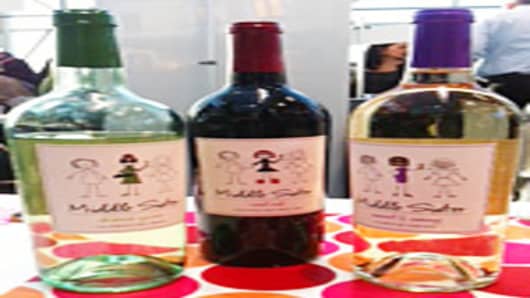Thirsty for Napa Valley’s best without the high price tag? You’re in luck.
The online wine retailer TastingRoom.comnow offers a solution for wine connoisseurs who wish to indulge in high-end wine by the glass at home.
"Consumers want to enjoy quality wine without necessarily opening an entire bottle," said the company's CEO Tim Bucher. "Our innovative product allows consumers to drink luxury and premium wines exactly how they want, when they want, wherever they want."
For $19, consumers can buy a single glass of 2007 Silver Oak Napa Cabernet Sauvignon or four glasses for $70. The wines are served in 3.4-ounce glass bottles that are replicas of the full-size bottles.
Although the company is currently selling only one brand, Bucher said it will launch five more luxury brands on March 22 and about 100 additional premium brands at the beginning of May. He added that he was “bullish on the wine-by-the-glass format” because it now accounts for the majority of total wine sales volume at many restaurants, according to a 2011 study by Ink Foundry.
Providing his customers with more options fueled Silver Oak CEO David Duncan’s decision to partner with the site.
“I think it gives the customer an option,” Duncan said. “If you’re going to have dinner with another person, you can open a bottle and finish it — no problem. But if your wife wants a white wine, and you want a red wine, I think it gives the customer a nice option for satisfying that desire.”
Wine Popularity and Exploration Grows
The company's new product is arriving at a boom time for wine. Last year, revenue for U.S. wineries was expected to grow 8.2 percent to $15.9 billion, according to IBISWorld.
Americans have been shifting away from imbibing beer in favor of wine due to wine’s perceived health benefits and the increased popularity of low-carb diets discouraging the consumption of beer.
Although sales shifted toward lower-priced wines during the recession , sales in the $20-plus category grew the most last year as consumers began to trade up to pricier wines.
“Since the crash, consumers traded down lock, stock and barrel — it didn’t matter what price point you were talking about,” said Rob McMillan, founder of Silicon Valley Bank Wine Division.
To correct an oversupply of high-end wine during the recession, wineries had to move the excess supply through the distribution channel so later vintages could sell at a normal price, McMillan said. But inventories have now come more into balance.
He added that “we should start to see some modest price increases this year” for wines across the board.
TastingRoom's new offering caters to consumers who are breaking out the corkscrew more often and whose tastebuds are more adventurous than those of older generations.
According to a recent Wine Market Council survey, 89 percent of older Millennials, who are 26- to 34-years old, and 86 percent of high-end buyers frequently purchased wines that they had not heard of previously.
An older Millennial and New York resident, Katy Schoenbeck, who attended the New York Wine Expo last week, said she often explores new wines but still remains loyal to a few vineyards.
“When I see them, I always buy them, but, otherwise, I’m always looking for the next best thing,” Schoenbeck said.
Building Customer Loyalty
Although consumers are exploring new wines, vineyards say they are still seeing repeat buyers.
“If you can give good value and good wine, they’ll stay with it,” said Rory Callahan, who manages U.S. operations for Wines of South Africa. The company represents about 580 wineries, which produce about 85 million cases annually.
“We don’t find them as fickle as you might think,” Callahan added.
In recent years, wineries have increased their direct shipments to consumers and launched wine clubs to ship bottles to customers on a regular basis.
“There are a lot of arcane laws out there that are changing so not every state is able to do this,” said Peter Kaufman, a managing partner at Bacchus Capital Management, which provides financing to wineries and also invests in them. “It’s an incredibly high-margin business for the winery. It gets rid of the middle man.”
Shipping directly to consumers is especially important because smaller wineries often have difficulty getting the attention of the big-box retailers, Kaufman added.
To build loyalty, vineyards are also hopping on the social-media bandwagon and reaching out to potential customers through company websites, Facebook, Twitter and Pinterest.
“That’s all we do for advertising — social media and online,” said Natalie Wassum, vice president of marketing at The Wine Sisterhood. “Social media is a huge emphasis in our company because that’s where people are connecting.”
The company’s Middle Sister brand includes several whimsical labels and names, such as Sweet & Sassy, Smarty Pants, Drama Queen and Rebel Red.
“To us, all of our brands have different personalities," Wassum said. "They all have different nicknames and have different varietals. Everyone kind of knows what a middle sister is — either they have one or they know one.”
Middle Sister’s branding strategy may appeal to the 60 percent of Millennials who place great importance on a “fun and contemporary” label for wine to drink at home.
Felicia Finch, a New York resident who stopped by The Wine Sisterhood’s table at the expo, said she often buys wines after being attracted by their labels.
“For instance, she has a wine called Sweet and Sassy,” she said. “That's me — that’s my personality. Even if I hadn’t tried it, I’d buy it on a whim.”
Questions? Comments? Email us at consumernation@cnbc.com. Follow Katie Little on Twitter @katie_little_.




